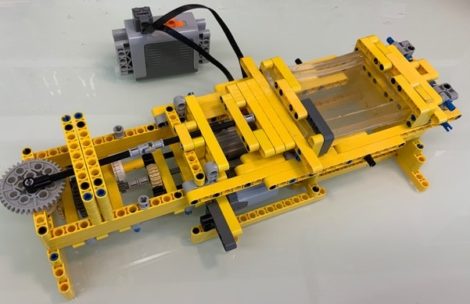Researchers use Lego to simulate cell mechanics

Equipped with a wheel and wired to a battery, this yellow-and-gray tool constructed from 326 pieces of Lego contains a silicone box in which cultured cells are stretched. Image: Etienne Boulter and Chloé C. Féral via AFP Relaxnews
Use Lego parts to reproduce mechanical stresses on human cells. This was the original idea devised by a team of Inserm scientists to offset the very costly human and material resources required for research of this type.
Reproducing the mechanical parameters of the environment in which cells develop represents a major challenge for cell biology researchers, as these processes are based on physical principles that go beyond their field of expertise. In addition, the equipment needed to perform such work is often very expensive to purchase and maintain.
To reduce costs, a team of Inserm researchers supervised by Chloé C. Féral, Inserm research director at the Institute for Research on Cancer and Aging, had the ingenious idea of using components made by the Danish brand Lego. With the colored plastic bricks and a motor, the scientists succeeded in building a device that reproduced the movement of cells, in order to study how they reacted to mechanical stress.
“We came up with the idea of developing tools for biophysical stimulation. As we are not physicists ourselves, we assembled our system with Lego bricks, which make it easy to use motors and gears, etc.,” explains Etienne Boulter, Inserm researcher and the main author of the study published in the Journal of Cell Sciences.
A customizable and easily accessible device
Equipped with a wheel and wired to a battery, the yellow-and-gray tool constructed from 326 pieces of Lego contains a silicone box in which cultured cells can be stretched on a constant axis.
“Put simply, the cells are cultivated in a flexible silicone box, stretched by the mechanical system. This generates stress on the cells, which can be studied using a wide range of classical cell biology techniques,” explains Etienne Boutler.
The scientists who came up with this original alternative point out that the device is customizable and could be of use in many disciplines, from biochemical techniques to imaging.
“It is a low-cost system that allows you to start a project without having to invest tens of thousands of euros in equipment. Lego makes it possible to assemble very inexpensive systems with components that are available virtually everywhere. This also allows researchers in countries with limited financial and technological resources to use this system,” explains Etienne Boutler. CL /ra
RELATED STORIES:
Caffeine may reduce harmful effects of diet rich in fat, sugar
Getting recommended amount of physical exercise linked to lower risk of 7 cancers